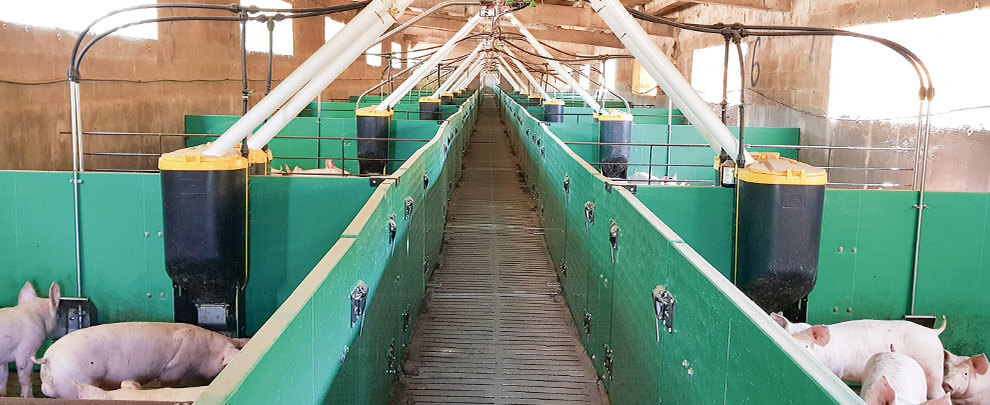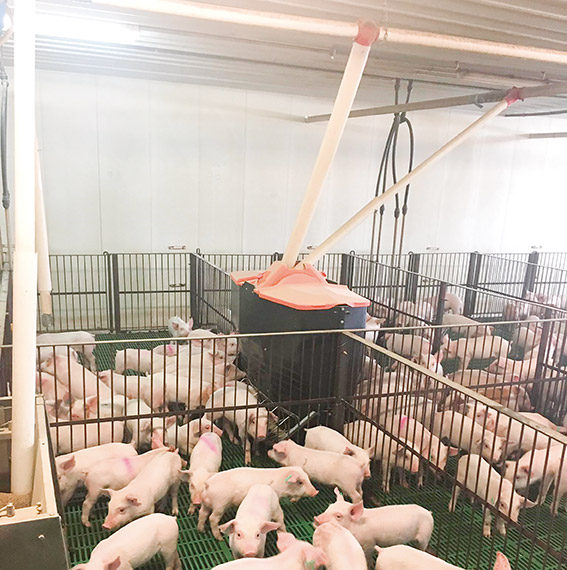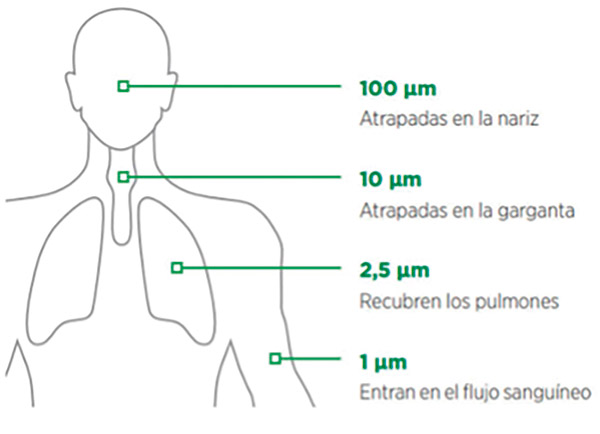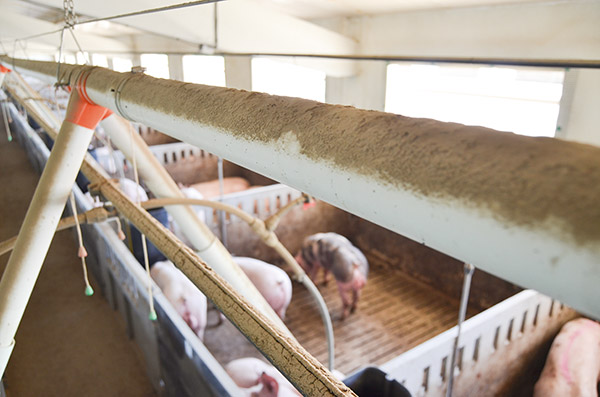Blog
Blog

Benefits of reducing environmental dust on farms
21 of October of 21 - Studies
Josep Rius. Rotecna R+D Department.
It was not many years ago that smoking was allowed in hospitals. Today this seems barbaric, but back then society was not aware of the harmful effects of tobacco on people's health. Something similar might happen with the quality of the air that pigs breathe on farms. The day we get the animals housed in a space where they can breathe air with less infectious agents, we will realize its importance. What does it take for us to implement preventive measures to reduce dust from the environment? Why is it important to decrease its presence?
It is essential to demonstrate the dangers and benefits of this subject and know how to convey the need for change to those who develop activities involving health risks. What does it take to change? Truthful, scientifically validated, and contrasted information that offers irrefutable evidence, acceptance and the conviction that prevention is the way to improve health and, finally, the means or tools to help implement the measures effectively.
In this sense, Rotecna has designed and incorporated lids for all its hoppers, intending to reduce the amount of dust present in the environment where the pigs are housed and where the people responsible for their care work. Because feed dust is one of how harmful pathogens present on farms are transported and dispersed, and because their proliferation increases the chances of transmission, lids are proposed to solve the problem.
Dust and animal health
The presence of dust inside the facilities comes mainly in feed, hair, skin peeling cells, dry droppings, etc. This dust can cause respiratory problems (enzootic pneumonia, Aujeszky, actinobacillosis, swine influenza, atrophic rhinitis and Glasser) and immunological diseases due to its relationship with bioaerosols (particles of biological origin suspended in the air). For example, one gram of powder can contain 800,000 live colibacilli. (1)
Pathogens that cause many diseases can survive for long periods in dust or organic matter. This survival time is specific to each pathogen and depends on many factors such as temperature, light exposure, humidity, and environmental pH. (2)
The size of the suspended particles determines the sedimentation rate. While the smaller ones are suspended, the thicker ones tend to settle on the soil and materials. Particles left in the air can be inhaled by animals and people working on the farm. Depending on their size, they are retained at different levels of the respiratory system. Dust causes severe irritation of the airways and the suppression of the microscopic defence mechanisms of the lung, which results in the cough that we all know.
Intensive livestock facilities are environments with a high load of bacteria combined with a high selective antimicrobial pressure, which favours the appearance of resistant bacteria. These, with dust, can be airborne and, in addition to spreading through the rooms or pens, can also be transported through natural or forced ventilation to the outside and spread, exposing animals, farmers or neighbours and the surrounding environment. (3)
According to the Best Available Swine Techniques Guide (MAPA), dust emitted by farms contributes to odour transport. In areas with a high density of pork production, dust clouds produced by a farm can transmit diseases to other farms. Inside animal housings, dust can affect both the animals' airways and those of their caretakers. (4)

Interior of a weaning farm. Photo: Rotecna.
Dust and people's health
As we have mentioned, the most common factor that causes respiratory diseases is the dust found inside the pens. This dust, however, affects not only animals but also the people who care for them. One of the most dangerous substances in dust are endotoxins, which originate in the cell wall of certain bacteria and cause airway irritation and inflammation. Workers who are occasionally exposed to environments loaded with endotoxins can suffer from the so-called toxic organic dust syndrome (ODTS) with symptoms such as headache, cough, muscle discomfort and even fever.
Prolonged exposure to environments with high dust concentrations can lead to bronchitis, rhinitis, pharyngitis, allergic reactions and skin irritations. In addition, separately or simultaneously with these pathologies, there may also be the possibility of contracting the so-called non-allergic asthma, which causes inflammation that causes the airways to narrow and makes it difficult to breathe. (5)
When talking about air pollution, reference bodies such as the World Health Organization (WHO) generally refer to the size of suspended particles: PM10, PM2.5 and PM1, particles smaller than 10 μm, 2.5 μm and 1 μm, respectively. The particles smaller than 10 μm can penetrate the human body's defences, enter the lungs and even reach blood flow.
A recent study (2019) by the National Centre for Occupational Environment Research in Copenhagen and Aalborg University (Denmark) identified 28 species of bacteria present in farm dust, which can pose risks to workers' health. (6)

One health
The WHO and the European Union (EU), in their Action Plan to Combat Antimicrobial Resistance, sets out the "One Health" approach (a term used to describe a principle that recognizes that human and animal health are interrelated, that diseases are transmitted from humans to animals and vice versa and, therefore, they must be dealt with in both cases) in which three main objectives stand out:
- Make the EU a model region for good practice, with greater coordination, surveillance and more appropriate control measures.
- Promote research, development, and innovation to offer new solutions and instruments for preventing and treating infectious diseases.
- Step up the EU's efforts worldwide to develop and lead a global agenda to combat antimicrobial resistance.
Antimicrobial resistance is a global health problem. Any action taken to reduce the generation and spread of antimicrobial resistance in humans and animals will positively affect everyone.
As we have seen, dust is the means through which resistant bacteria travel through the air, both inside and outside farms. Preventing their formation and spread reduces animals' infection rate and strengthens their immune system, improving their well-being and economic productivity.

Dust can cause various diseases. Photo: Rotecna.
The LIDS in the hoppers
Because of the issues mentioned earlier, we believe that the hoppers' lids are the way to reduce the environmental dust generated by the feed. As we have seen, not all dust comes from the feed, but an important part does since it is claimed to represent a direct loss of 1% of it. These arguments are more than enough for farmers to be informed and know what benefits can be provided by lids on the hoppers, to which we must also add other advantages related to the protection and conservation of feed, such as:
- Keep the feed fresh and dry, free of moisture and possible fermentation.
- Preserve the nutritional and organoleptic properties of the feed in optimal conditions.
- Avoid evaporation of the aromatic components of the feed of piglets of early ages, which makes it a much more appetizing feed.
- Protect feed from access by insects, birds, and rodents, which cause food loss and waste and are a significant factor in feed contamination and, consequently, a severe threat to animal health.
- Minimize feed loss with consequent economic savings.
- Improve average daily consumption and digestive performance, which affects the conversion rate.
Undoubtedly, pork is a sector that has always been characterized by its capacity and dynamism to incorporate all the improvements that allow it to optimize the performance of its animals and carry out sustainable production. Proof of this is the rapid reaction it had and continues to have in reducing the need to use antibiotics or the application of all kinds of biosecurity measures, both external and internal, to preserve livestock health. Likewise, applying prevention measures such as those mentioned above reduces the amount of contaminated dust that animals and people inhale daily.
How to reduce dust concentration
- Ventilate correctly, keeping the system clean and in good condition.
- Keep relative humidity low (40-70%).
- Use lids on the hoppers.
- Proper layout of the feed and distribution system.
- Clean and disinfect properly.
- Add fat and oil to the diet.
- Apply dust collection systems: spraying with oil.
- Apply techniques that catch dust using static electricity.
- By ozone treatment.
REFERENCES:
(1) Jacho López, M.A. (2010) “Recomendaciones prácticas para reducir el Impacto Ambiental en granjas porcinas”. Engormix: https://www.engormix.com/porcicultura/articulos/recomendaciones-practicas-reducir-impacto-t28529.htm (2) Redacción (2020) “Bioseguridad en granja porcina: transmisión por aerosol y oral (2 de 2)”. Porci News: https://porcino.info/bioseguridad-en-granja-porcina-transmision-por-aerosol-y-oral-2-de-2/ (3) Coulon, F (2020) “Farm dust resistomes and bacterial microbiomes in European poultry and pig farms”. Science Direct: https://www.sciencedirect.com/science/article/pii/S0160412020319267 (4) García Sanz, I. et al. (2010) “Guía de mejores técnias disponibles del sector porcino”. MAPA: https://www.mapa.gob.es/es/ganaderia/publicaciones/GuiaMTDsSectorPorcino_tcm30-105316.pdf (5) Donham, K. (2017) “Riesgos para la salud y la seguridad de los productores de porcino“. 3tres3: https://www.3tres3.com/articulos/riesgos-para-la-salud-y-la-seguridad-de-los-productores_38891/ (6) Keer White, J., Lund Nielsen, J., Mette Madsen, A. (2018) “Microbial species and biodiversity in settling dust within and between pig farms”. Science Direct: https://www.sciencedirect.com/science/article/pii/S0013935119300088 (7) Coma, J. (2010) “Reducción de las emisiones de gases invernadero en la fábrica y en la granja “. 3tres3: https://www.3tres3.com/articulos/reduccion-de-los-gases-invernadero-en-fabrica-y-granja_2895/






